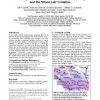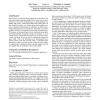1542 search results - page 251 / 309 » Redundancy in Spatial Databases |
SSD
2005
Springer
14 years 2 months ago
2005
Springer
This paper proposes and solves a-autonomy and k-stops shortest path problems in large spatial databases. Given a source s and a destination d, an aautonomy query retrieves a sequen...
KDD
2004
ACM
14 years 2 months ago
2004
ACM
Detection of space-time clusters is an important function in various domains (e.g., epidemiology and public health). The pioneering work on the spatial scan statistic is often use...
WMASH
2003
ACM
14 years 2 months ago
2003
ACM
To be widely adopted, location-aware computing must be as effortless, familiar and rewarding as web search tools like Google. We envisage the global scale Place Lab, consisting of...
ICPR
2002
IEEE
14 years 1 months ago
2002
IEEE
We describe spatio-temporal symmetry and its extraction via a Generalised Symmetry Operator. Its use in gait recognition is reinforced by the view from psychology that human gait ...
CIKM
2009
Springer
14 years 1 months ago
2009
Springer
Indoor spaces accommodate large populations of individuals. The continuous range monitoring of such objects can be used as a foundation for a wide variety of applications, e.g., s...


